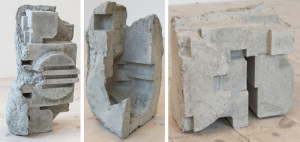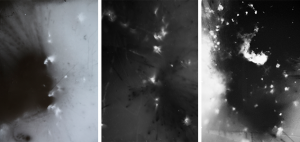Born in 1988, Jasmin Daryani studied at the Valand Academy in Gothenburg and the University College of Arts, Crafts and Design in Stockholm, where she received her Master’s Degree in 2015. Hilde Retzlaff was born in 1990 and has a Bachelor’s Degree from the University College of Arts, Crafts and Design. She will receive her MA from the Swedish Royal Institute of Art this year.
Hilde Retzlaff works in an invigorating and intuitive manner when collecting materials, where her method or approach is a crucial part of the working process. By deconstructing existing materials, such as packaging, carpets, posters and sacks, she reveals a new way of understanding the properties and qualities of the actual materials themselves. Through the creation of collage and sculpture, Retzlaff very consciously devotes attention to and reshapes a material that would otherwise end up in a rubbish heap.
In her work, Jasmin Daryani visits concepts of representation, belonging and migration. Through her use of photography, text, silk-screen and archive materials, she examines social and political constructions, using specific events to uncover alternative stories. In her piece Where Do We Go From Here?, Jasmin Daryani presents burnt-out cars in various suburban settings, characteristic of her interest in the media’s portrayal of the suburbs, and issues pertaining to the city centre and periphery. To Disembody has its starting point in Jasmin Daryani’s birth in war-torn Iran. Through a series of lightboxes and photographs, she shows an explosion as a force and a phenomenon, where the aftermath remains in the form of still images.
Maria Bonnier Dahlin Foundation
The Maria Bonnier Dahlin Foundation awards annual grants to two or three young artists, in order to support young Swedish visual artists and their work. The foundation was established in 1985 by Jeanette Bonnier (1934–2016), in memory of her daughter Maria, who was killed in an automobile accident at the age of 20. Maria was studying architecture at Columbia University in New York City, and surrounded herself with a community of young artists. Since its inception 79 artists – including Cecilia Edefalk, Mamma Andersson and Gunnel Wahlstrand – have been awarded foundation grants.
Sofia Curman and Angelika Knäpper were guest members of the 2016 jury.

Explanatory statement of the jury for Hilde Retzlaff:
Hilde Retzlaff develops her own mythology as she scrapes up the world’s remains and people’s rubbish, methodically and carefully transforming the materials into something new. Her work contains an intrinsic longing to locate the full potential of each material; much like an alchemist, she sets out to refine each material, elevating it from its current state. In her collages, poster paper becomes even more paper-like, while old clothing takes on even more textile-like properties when woven into a rug. In her sculpture series Logogram, the found objects appear to be fossils. Displayed as an imprint in concrete, an object itself is unidentifiable, its only presence its absence; silent and avoidable, yet an immensely powerful and distinctly meaningful symbol of our time. Hilde Retzlaff states that she finds herself in the midst of a spiritual journey. We look forwards to following her.

Explanatory statement of the jury for Jasmin Daryani:
Jasmin Daryani possesses the incredible ability to enlist the power of poetry to express one of our society’s biggest failures. Her photographs are simultaneously intimate and rock-hard. With their clarity and strength, they make it impossible to look the other way, and the realisation of the complex significance of a burnt-out car has a profound effect. Jasmin Daryani offers proof of the unparalleled ability of art to visualise the world that we otherwise shy away from, when we are otherwise fed with simplified explanations and fear. She mines the ashes after the explosion, shaping them into a language for an entire generation. We urge everyone to listen.